Translation theories
- 格式:ppt
- 大小:1.06 MB
- 文档页数:26
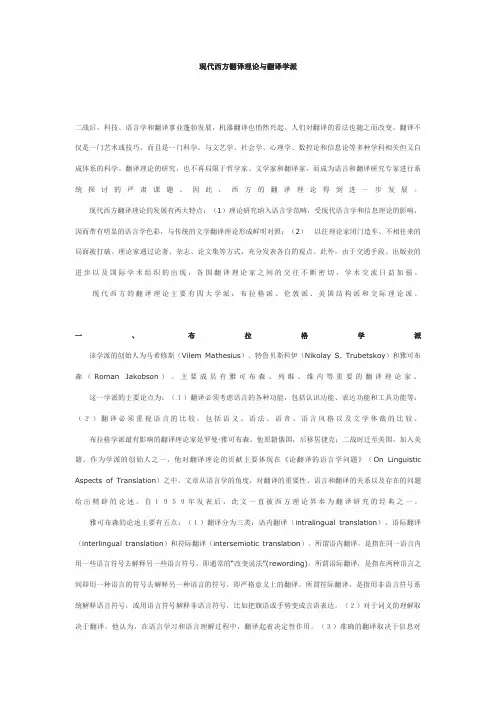
现代西方翻译理论与翻译学派二战后,科技、语言学和翻译事业蓬勃发展,机器翻译也悄然兴起。
人们对翻译的看法也随之而改变。
翻译不仅是一门艺术或技巧,而且是一门科学,与文艺学、社会学、心理学、数控论和信息论等多种学科相关但又自成体系的科学。
翻译理论的研究,也不再局限于哲学家、文学家和翻译家,而成为语言和翻译研究专家进行系统探讨的严肃课题。
因此,西方的翻译理论得到进一步发展。
现代西方翻译理论的发展有两大特点:(1)理论研究纳入语言学范畴,受现代语言学和信息理论的影响,因而带有明显的语言学色彩,与传统的文学翻译理论形成鲜明对照;(2)以往理论家闭门造车、不相往来的局面被打破。
理论家通过论著、杂志、论文集等方式,充分发表各自的观点。
此外,由于交通手段、出版业的进步以及国际学术组织的出现,各国翻译理论家之间的交往不断密切,学术交流日益加强。
现代西方的翻译理论主要有四大学派:布拉格派、伦敦派、美国结构派和交际理论派。
一、布拉格学派该学派的创始人为马希修斯(Vilem Mathesius)、特鲁贝斯科伊(Nikolay S. Trubetskoy)和雅可布森(Roman Jakobson)。
主要成员有雅可布森、列维、维内等重要的翻译理论家。
这一学派的主要论点为:(1)翻译必须考虑语言的各种功能,包括认识功能、表达功能和工具功能等;(2)翻译必须重视语言的比较,包括语义、语法、语音、语言风格以及文学体裁的比较。
布拉格学派最有影响的翻译理论家是罗曼·雅可布森。
他原籍俄国,后移居捷克;二战时迁至美国,加入美籍。
作为学派的创始人之一,他对翻译理论的贡献主要体现在《论翻译的语言学问题》(On Linguistic Aspects of Translation)之中。
文章从语言学的角度,对翻译的重要性、语言和翻译的关系以及存在的问题给出精辟的论述。
自1959年发表后,此文一直被西方理论界奉为翻译研究的经典之一。
雅可布森的论述主要有五点:(1)翻译分为三类:语内翻译(intralingual translation)、语际翻译(interlingual translation)和符际翻译(intersemiotic translation)。
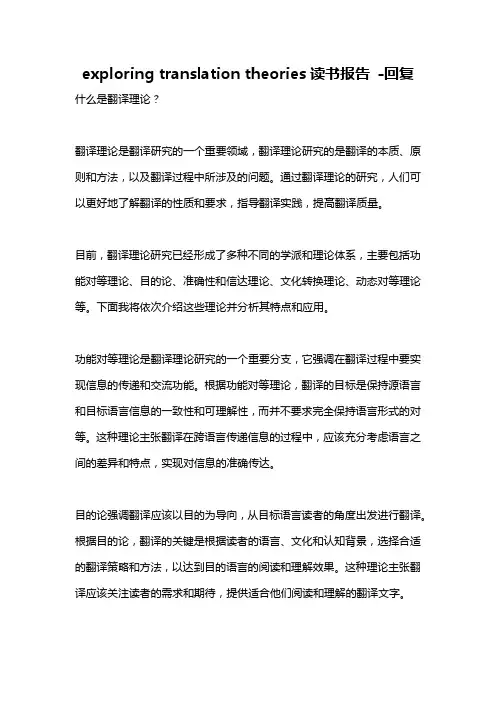
exploring translation theories读书报告-回复什么是翻译理论?翻译理论是翻译研究的一个重要领域,翻译理论研究的是翻译的本质、原则和方法,以及翻译过程中所涉及的问题。
通过翻译理论的研究,人们可以更好地了解翻译的性质和要求,指导翻译实践,提高翻译质量。
目前,翻译理论研究已经形成了多种不同的学派和理论体系,主要包括功能对等理论、目的论、准确性和信达理论、文化转换理论、动态对等理论等。
下面我将依次介绍这些理论并分析其特点和应用。
功能对等理论是翻译理论研究的一个重要分支,它强调在翻译过程中要实现信息的传递和交流功能。
根据功能对等理论,翻译的目标是保持源语言和目标语言信息的一致性和可理解性,而并不要求完全保持语言形式的对等。
这种理论主张翻译在跨语言传递信息的过程中,应该充分考虑语言之间的差异和特点,实现对信息的准确传达。
目的论强调翻译应该以目的为导向,从目标语言读者的角度出发进行翻译。
根据目的论,翻译的关键是根据读者的语言、文化和认知背景,选择合适的翻译策略和方法,以达到目的语言的阅读和理解效果。
这种理论主张翻译应该关注读者的需求和期待,提供适合他们阅读和理解的翻译文字。
准确性和信达理论认为翻译的目标是准确地传达原文的意思,并在目标语言中产生与原文意义相一致的效果。
根据准确性和信达理论,翻译的质量与原文的一致性、完整性和准确性密切相关,翻译应该尽可能地保持原文的信息和语气。
这种理论主张翻译在追求完美准确性的同时,也应该符合目标语言的特点和口感。
文化转换理论认为翻译是一种文化转换的过程,翻译不仅涉及语言的转换,更涉及到文化背景、价值观念和社会习俗等方面的转换。
根据文化转换理论,翻译应该尊重原文所处的文化环境,理解并传达原文所包含的文化内涵。
这种理论主张翻译应该避免文化冲撞和文化误解,促进不同文化之间的交流和理解。
动态对等理论认为翻译是一个动态的过程,翻译不能只关注原文和目标文本之间的对等关系,还需要考虑翻译过程中的动态变化和调整。
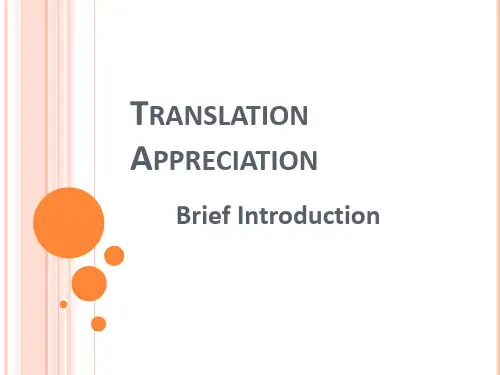
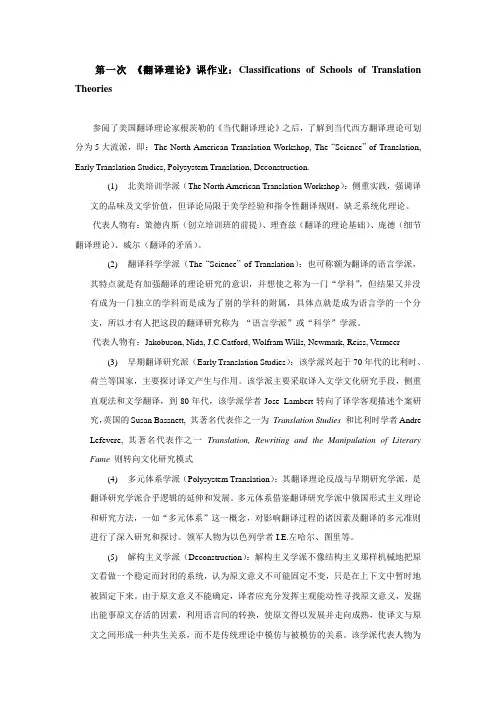
第一次《翻译理论》课作业:Classifications of Schools of Translation Theories参阅了美国翻译理论家根茨勒的《当代翻译理论》之后,了解到当代西方翻译理论可划分为5大流派,即:The North American Translation Workshop, The “Science” of Translation, Early Translation Studies, Polysystem Translation, Deconstruction.(1)北美培训学派(The North American Translation Workshop):侧重实践,强调译文的品味及文学价值,但译论局限于美学经验和指令性翻译规则,缺乏系统化理论。
代表人物有:策德内斯(创立培训班的前提)、理查兹(翻译的理论基础)、庞德(细节翻译理论)、威尔(翻译的矛盾)。
(2)翻译科学学派(The “Science”of Translation):也可称额为翻译的语言学派,其特点就是有加强翻译的理论研究的意识,并想使之称为一门“学科”,但结果又并没有成为一门独立的学科而是成为了别的学科的附属,具体点就是成为语言学的一个分支,所以才有人把这段的翻译研究称为“语言学派”或“科学”学派。
代表人物有:Jakobuson, Nida, J.C.Catford, Wolfram Wills, Newmark, Reiss, Vermeer(3)早期翻译研究派(Early Translation Studies):该学派兴起于70年代的比利时、荷兰等国家,主要探讨译文产生与作用。
该学派主要采取译入文学文化研究手段,侧重直观法和文学翻译,到80年代,该学派学者Jose Lambert转向了译学客观描述个案研究,英国的Susan Bassnett, 其著名代表作之一为Translation Studies 和比利时学者Andre Lefevere, 其著名代表作之一Translation, Rewriting and the Manipulation of Literary Fame则转向文化研究模式(4)多元体系学派(Polysystem Translation):其翻译理论反战与早期研究学派,是翻译研究学派合乎逻辑的延伸和发展。
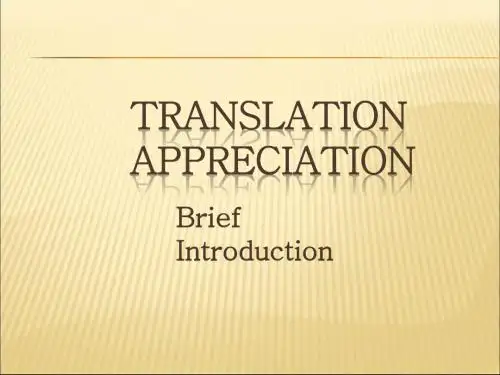
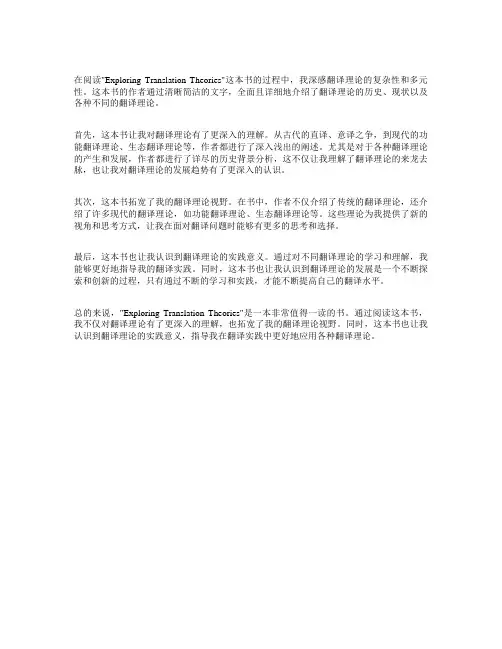
在阅读"Exploring Translation Theories"这本书的过程中,我深感翻译理论的复杂性和多元性。
这本书的作者通过清晰简洁的文字,全面且详细地介绍了翻译理论的历史、现状以及各种不同的翻译理论。
首先,这本书让我对翻译理论有了更深入的理解。
从古代的直译、意译之争,到现代的功能翻译理论、生态翻译理论等,作者都进行了深入浅出的阐述。
尤其是对于各种翻译理论的产生和发展,作者都进行了详尽的历史背景分析,这不仅让我理解了翻译理论的来龙去脉,也让我对翻译理论的发展趋势有了更深入的认识。
其次,这本书拓宽了我的翻译理论视野。
在书中,作者不仅介绍了传统的翻译理论,还介绍了许多现代的翻译理论,如功能翻译理论、生态翻译理论等。
这些理论为我提供了新的视角和思考方式,让我在面对翻译问题时能够有更多的思考和选择。
最后,这本书也让我认识到翻译理论的实践意义。
通过对不同翻译理论的学习和理解,我能够更好地指导我的翻译实践。
同时,这本书也让我认识到翻译理论的发展是一个不断探索和创新的过程,只有通过不断的学习和实践,才能不断提高自己的翻译水平。
总的来说,"Exploring Translation Theories"是一本非常值得一读的书。
通过阅读这本书,我不仅对翻译理论有了更深入的理解,也拓宽了我的翻译理论视野。
同时,这本书也让我认识到翻译理论的实践意义,指导我在翻译实践中更好地应用各种翻译理论。
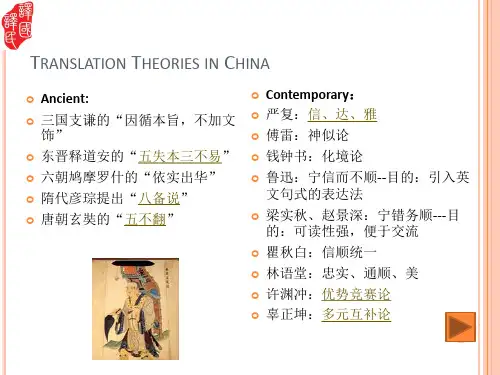
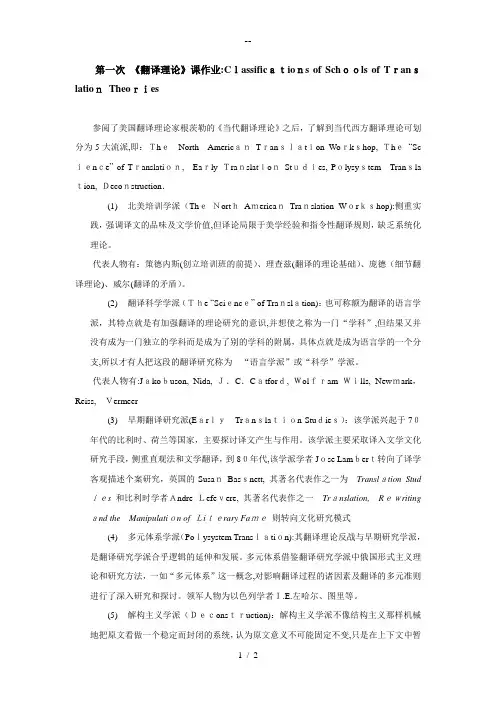
第一次《翻译理论》课作业:Classifications of Schools of TranslationTheories参阅了美国翻译理论家根茨勒的《当代翻译理论》之后,了解到当代西方翻译理论可划分为5大流派,即:TheNorth AmericanTranslation Workshop, The“Sc ience”of Translation,Early TranslationStudies, Polysystem Transla tion, Deconstruction.(1)北美培训学派(TheNorthAmericanTranslation Workshop):侧重实践,强调译文的品味及文学价值,但译论局限于美学经验和指令性翻译规则,缺乏系统化理论。
代表人物有:策德内斯(创立培训班的前提)、理查兹(翻译的理论基础)、庞德(细节翻译理论)、威尔(翻译的矛盾)。
(2)翻译科学学派(The “Science” of Translation):也可称额为翻译的语言学派,其特点就是有加强翻译的理论研究的意识,并想使之称为一门“学科”,但结果又并没有成为一门独立的学科而是成为了别的学科的附属,具体点就是成为语言学的一个分支,所以才有人把这段的翻译研究称为“语言学派”或“科学”学派。
代表人物有:Jakobuson, Nida, J.C.Catford, Wolfram Wills, Newmark,Reiss,Vermeer(3)早期翻译研究派(EarlyTranslation Studies):该学派兴起于70年代的比利时、荷兰等国家,主要探讨译文产生与作用。
该学派主要采取译入文学文化研究手段,侧重直观法和文学翻译,到80年代,该学派学者Jose Lambert转向了译学客观描述个案研究,英国的SusanBassnett, 其著名代表作之一为Translation Stud ies 和比利时学者Andre Lefevere, 其著名代表作之一Translation,Rewriting and the Manipulation of Literary Fame则转向文化研究模式(4)多元体系学派(Polysystem Translation):其翻译理论反战与早期研究学派,是翻译研究学派合乎逻辑的延伸和发展。
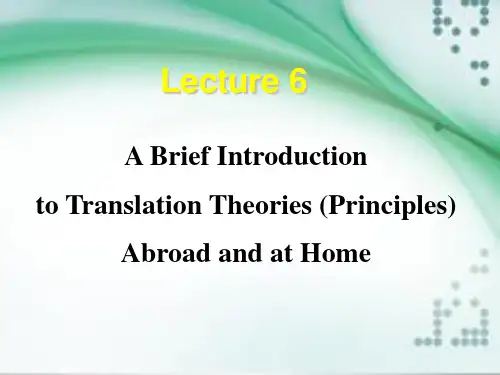
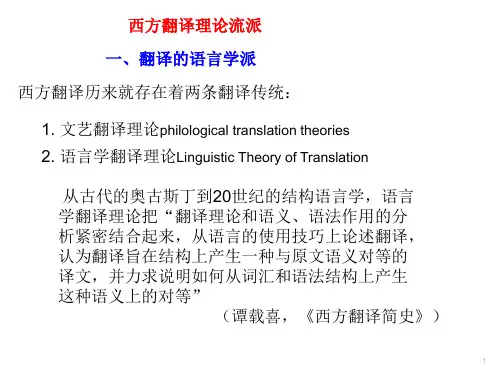
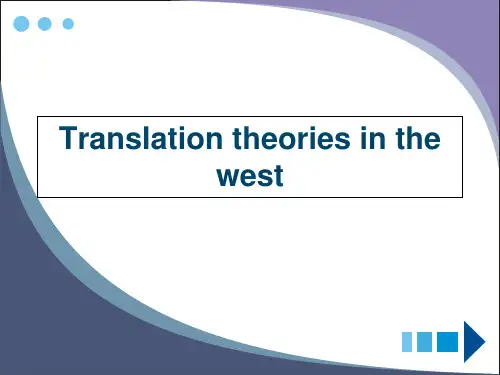
翻译理论与实践(汉译英)Translation Theories and Practice (Chinese-English Translation )Teaching Notes for Senior College Students(2005年9月)刘国忠2578706*************.cnTopics at first:1. 解读汉译英《教学大纲》2. 解读汉译英《考试大纲》3. 汉译英学习指导①重要性②特性③实践性汉译英精典教材:1. 《英汉翻译教程》张培基喻天根《汉英翻译教程》吕瑞昌喻天根上海外语教育出版社 1980.92.《汉英翻译基础》陈宏薇上海外语教育出版社 1998/23.《英汉互译实用教程》宋天锡等国防工业出版社2000/14.《实用翻译教程》(英汉互译)增订本冯庆华上海外语教育出版社2002/55.《实用汉英翻译教程》曾诚外语教学与研究出版社2002/46.《翻译教学:实务与理论》刘宓庆中国对外翻译出版公司2003/1•汉译英主要内容:•一、汉译英实务教学•二、历届TEM8汉译英试卷评析•三、汉译英练习与评析•—汉英翻译强化训练汉译英实务教学主要内容一、汉英词语对比二、汉英句法基本差异(一)汉英句子的主语比较三、汉英句法基本差异(二)汉语谓语动词的分析和翻译四、被动语态的翻译五、汉译英中的主谓定位六、汉译英中的句子整合问题增补内容:七、如何避免翻译中的Chinglish八、汉英翻译中的文化传递九、公示语的翻译十、历届TEM8汉译英试卷评析十一、汉译英练习与评析—汉英翻译强化训练汉译英学习指导(一)如何保证翻译课的教学效果1.以―正当程序‖保证翻译质量无论英译汉,还是汉译英,译文都需要准确、通顺,这是翻译的基本要求。
表达准确的基础是对原文的准确理解:译者必须准确地理解原文的每个词、每句话和作者的意图。
表达通顺的基础是对译入语的熟练运用。
我们在做汉译英时,存在一个天然的劣势:由于英语不是我们的母语,做到表达的准确和通顺相当困难。
. Brief Introduction of Eugene NidaDr. Eugene A. Nida (1914--) is one of the most distinguished contemporary translation theorists in the west. During his past fifty years of study in translation theory and practice, he has achieved great success in this field. His translation theory has exerted a tremendous influence on the translation studies not only in western countries but also in Asian countries, especially in China. He is generally recognized as the most influential one among all the contemporary translation theorists.He develops the communicative translation theory put forward by Newmark, who is a famous translation theorist of England. The communicative translation theory not only emphasizes language meaning transform, but also functional equivalence. Spreading and becoming popular in China in early 1980s, Nida’s translation theory is the debut for most of Chinese translators to contact the western systematic translation theories and has deeply influenced the translation theory research in China. In spite of the doubts on his theory appearing in late 1980s and early 1990s, it is certain that Nida’s translation theory gives significant inspiration to translation researchers.With the research fruits of modern linguistics, Nida has carries out a descriptive research on translation and contemplated deeply on the major problems of the practice and research of the translation theory. With an active mind, he frequently renews the translation theory and keeps rectifying and developing his thoughts and ideas about translation theory. His translation theory is mainly on the basis of the developments of contemporary linguistics, communication theory, information theory and semiotics.2. Nida’s Functional Equivalence Theory2.1 Conception of Functional EquivalenceFunctional equivalence theory was first put forward in 1964. This principle emphasizes the functional equivalence of information instead of the direct formal equivalence in translation so as to keep the meaning and style of the source language functionally equivalent to that of the target language as much as possible. The functional feature of the translation depends on the balance of two relationships, that is, the relationship between the target language receptor and the target text should generally be equivalent to the relationship between the source language receptor and the source text, and it is the two relationships that provide the basis for functional equivalence.2.2 Literal Translation, Free Translation and Functional EquivalenceNida is the first person to handle the disputable problem between literal translation and free translation. He holds that effect is the most important element in translation. Regardless of the method of literal translation or free translation is followed, as long as the response of both source language reader and target language reader is somewhat equivalent, the best translation can be achieved.In traditional translation theory, literal translation focusing on form is called faithful, while translation emphasizing meaning is free. Nida insists translator focusing on form, especially in verses, sentences and concepts equivalence, is formal equivalence. It is dangerous in reproducing intention and meaning of original author, even worse, to result in reader’s misunderstanding. In his opinion, the translator following functional equivalence will be more faithful to the original text than following literal translation, for that the former strategy requires more fully and comprehensively understanding of the meaning of original text. Moreover.2.3 Four Levels of Functional Equivalence.Translation involves message transmission between two languages and cultures, and therestill exists lots of similarity among different language cultures, which is the objective basis. Because of the different location, history, cultural ground and education level, it is hard to be objective. The definition of translation Nida proposed shows that translation is not only related to equivalence of lexical meaning, but also the equivalence of text connotation and style, message translated in translation includes surface lexical message and deep cultural message. Functional equivalence includes four levels: lexical equivalence, sentence equivalence, passage equivalence and style equivalence.2.3.1 Lexical equivalenceThe meaning of a word lies in its usage in language. In translation practice, what confuse us is how to find the corresponding meaning in target language. Take Tension is building up as an example, tension and build up both have different explanations without consideration of context. Thus this sentence can be translated as several different editions:In English—Chinese translation, completely lexical equivalence lies in special terms and terminology, besides which there are five correspondences, word equivalence, synonymy, polysemy, lexical meaning overlap and zero equivalence.2.3.2 Sentence EquivalenceSentence equivalence is more complicated than lexical equivalence. In English- Chinese translation, singular and plural form is an important and evident problem. Plural meaning in Chinese is not expressed with any evident plural form, which is different in English. Moreover, for different target language, tender, number and tense should be taken into consideration in translation. Thus, translator should be clear about whether such a sentence grammar exists in the target language or not, and be clear about the frequency of such sentence grammar.2.3.3 Passage EquivalenceIn order to achieve passage equivalence, language is not the unique element we should consider, what we should also take into consideration is how the language represents meaning and performs its function in a specific context. Passage equivalence consists of three parts, passage context, scene context and cultural context. Passage context lies in analysis of language, which aims to judge the meaning of words and semantic units in original text, and is based on analysis of meaning and connotation of the passage. Scene context includes the concrete person and things involved in communication, the channel of communication, the relationship among participants and mental emotions.3. ConclusionNida’s translation theory has been popular in the world for nearly sixty years and it has become an indispensable part of translation studies. Holding a panoramic view of all the important points in Nida’s theory, we can conclude that the essence of his theory is that he insists the translator should pay prior attention to the meaning of the source text and should not be curbed by the expression form of the source text. Moreover, Nida’s translation theory is a genuine breakthrough and its influence and contribution to the translation field cannot be underestimated, and it dose render us a profound enlightenment that the excellent translation comes from practice.Nida has been a pioneer in the fields of translation theory and linguistics.His Ph.D. dissertation, A Synopsis of English Syntax, was the first full-scale analysis of a major language according to the "immediate-constituent" theory. His most notable contribution to translation theory is Dynamic Equivalence, also known as Functional Equivalence. For more information, see "Dynamic and formal equivalence." Nida also developed the"componential-analysis" technique, which split words into their components to help determine equivalence in translation (e.g. "bachelor" = male + unmarried). This is, perhaps, not the best example of the technique, though it is the most well-known.Nida's dynamic-equivalence theory is often held in opposition to the views of philologists who maintain that an understanding of the source text(ST) can be achieved by assessing theinter-animation of words on the page, and that meaning is self-contained within the text (i.e. much more focused on achieving semantic equivalence).This theory, along with other theories of correspondence in translating, are elaborated in his essay Principles of Correspondence,[6]where Nida begins by asserting that given that “no two languages are identical, either in the meanings given to corresponding symbols or in the ways in which symbols are arranged in phrases and sentences, it stands to reason that there can be no absolute correspondence between languages. Hence, there can be no fully exact translations.”[7] While the impact of a translation may be close to the original, there can be no identity in detail.Nida then sets forth the differences in translation, as he would account for it, within three basic factors: (1) The nature of the message: in some messages the content is of primary consideration, and in others the form must be given a higher priority. (2) The purpose of the author and of the translator: to give information on both form and content; to aim at full intelligibility of the reader so he/she may understand the full implications of the message; for imperative purposes that aim at not just understanding the translation but also at ensuring no misunderstanding of the translation. (3) The type of audience: prospective audiences differ both in decoding ability and in potential interest.Nida brings in the reminder that while there are no such things as “identical equivalents” in translating, what one must in translating seek to do is find the “closest natural equivalent”. Here he identifies two basic orientations in translating based on two different types of equivalence: Formal Equivalence (F-E) and Dynamic Equivalence (D-E).F-E focuses attention on the message itself, in both form and content. Such translations then would be concerned with such correspondences as poetry to poetry, sentence to sentence, and concept to concept. Such a formal orientation that typifies this type of structural equivalence is called a “gloss translation” in which the translator aims at reproducing as literally and meaningfully as possible the form and content of the original.The principles governing an F-E translation would then be: reproduction of grammatical units; consistency in word usage; and meanings in terms of the source context.D-E on the other hand aims at complete “naturalness” of expression. A D-E translation is directed primarily towards equivalence of response rather than equivalence of form. The relationship between the target language receptor and message should be substantially the same as that which existed between the original (source language) receptors and the message.The principles governing a D-E translation then would be: conformance of a translation to the receptor language and culture as a whole; and the translation must be in accordance with the语言学派翻译理论奥古斯丁发展了亚里士多德的“符号”理论,提出了语言符号的“能指”、“所指”和译者“判断”的三角关系,开创了西方翻译理论的语言学传统。
Introduction to the Course of Translation Theories and PracticeQuestions for discussion1. What is translation?2. How many categories do you think translation can be divided into, and what are they?3. What are the characteristics of translation? Describe it in detail, please.4. What is style and stylistics? What is the relationship between style and translation?5. What are we going to learn in this course?6. What is translation theory and what are translation techniques? What is the relationship between them?7. As a translator, what competence should you have? Can you describe it in detail?8. How can we learn the course well?·Translation is as old as a language itself , probably starting from thousands years ago . It has been used as an indispensable means of mediation , a useful aid to preaching and teaching , and to the social and culture , and commercial exchanges and mutual understanding between different peoples and different countries . It has become part of human life.Definitions of translation1) Translation consists in reproducing in the receptor language the closest natural equivalent of the source language, first in terms of meaning and secondly in terms of style.所谓翻译,是在译语中用最切近的自然的对等语再现原语的信息,首先是意义,其次是文体.2) The replacement of textual material in one language (SL) by equivalent textual material in another language (TL).翻译可作如下界定:用一种语言(目的语)的文本材料对等地再现另一种语言(出发语)的文本材料.3) A translation should give a complete transcript of the ideas of the original work. The style and manner of writing should be of the same character as that of the original. A translation should have all the ease of the original composition.Definitions of translation译文应完全复写出原作的思想。
翻译有哪些理论翻译学中的理论有很多,以下是其中的一些主要理论:1.等效理论(Equivalence Theory):由Eugene Nida和Charles Taber于1960年提出。
该理论认为翻译的目标是在不同语言之间传达与源文本相等或相似的意义。
它强调翻译的等级和程度,分为准确传递(充分等效)、部分传递(偏远等效)和恢复信息(零等效)。
2.功能对等理论(Functional Equivalence Theory):由Christiane Nord于1991年提出。
该理论认为翻译的目标是根据目标语言和文化的读者需求,在功能上等效于源文本。
它强调翻译的目的是满足读者对论述、表述和信息的期望,并做出相应调整。
3.文化翻译理论(Cultural Translation Theory):由AndréLefevere于1992年提出。
该理论认为翻译是一种文化间的传递和变革过程,强调翻译的文化因素对于意义的建构和解读至关重要。
它探讨了源文本和目标文本之间的文化差异,并提出了译者作为文化中介者的角色。
4.再现理论(Relevance Theory):由Dan Sperber和Deirdre Wilson于1986年提出。
该理论认为翻译的目标是传递有效沟通所需的信息,并尽可能减少读者的认知努力。
它强调翻译要遵循言语交际原则,提供最相关和最明确的信息,以确保双方的理解和交流。
5.干扰理论(Interference Theory):源于歧义和误会的语言干扰现象。
干扰理论认为翻译是在源语言和目标语言之间进行的,源语言结构和表达方式会对译文产生不同程度的影响。
干扰理论研究译者如何解决干扰问题,以确保翻译的准确性和流畅性。
6.社会文化理论(Sociocultural Theory):由Lev Vygotsky于20世纪初提出。
社会文化理论认为翻译是一种社会和文化实践,翻译活动受到社会环境和文化背景的影响。
它研究翻译与社会和文化因素之间的相互关系,强调译者的角色和社会文化认知对翻译的重要性。